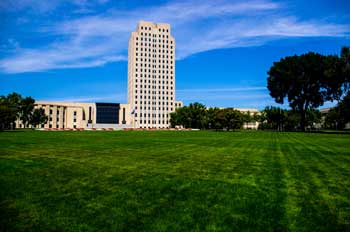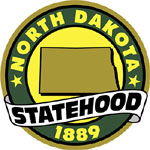ABOUT North Dakota
Capital: Bismarck
State abbreviation/Postal code: N.D./ ND
Nickname: Flickertail State / Peace Garden State / Sioux State
Origin of name: Dakota is the Sioux Indian word for "friend".
Briefs on Noth Dakota:
 Located in the north of the united states, between Canada and South Dakota, the state of North Dakota features the northern plains, the badlands in the south and the Missouri running trough the center of the city. To the north of the state are the Canadian provinces pf Saskatchewan and Manitoba, on the west is Montana, on the south, South Dakota and Minnesota on the east.
Located in the north of the united states, between Canada and South Dakota, the state of North Dakota features the northern plains, the badlands in the south and the Missouri running trough the center of the city. To the north of the state are the Canadian provinces pf Saskatchewan and Manitoba, on the west is Montana, on the south, South Dakota and Minnesota on the east.
The natural beauty of the state is charismatic as well as bewitching. The enticement of the state had made great personalities such as Theodore Roosevelt hail its scenic splendor.
 The capital of the state is the famous city of Bismarck. Offering countless timeless attractions Bismarck is believed to be one of the most attractive places in the entire country. The popular pulls of the city are Governor's Mansion, North Dakota Heritage Center which includes museums, state archives and art gallery, the Railroad Gallery and the Cathedral Area Historic District.
The capital of the state is the famous city of Bismarck. Offering countless timeless attractions Bismarck is believed to be one of the most attractive places in the entire country. The popular pulls of the city are Governor's Mansion, North Dakota Heritage Center which includes museums, state archives and art gallery, the Railroad Gallery and the Cathedral Area Historic District.
The largest city of the state is Fargo. Fargo is a typical metropolitan city that is located in the far east, across the Red River from Moorhead, Minnesota. From beautiful art and architecture, grand museums to huge houses and buildings, thrilling nightlife and festivals, the city has something for everyone.
However the state has nit just abundance of lures. It has also a rich history to its name. The Native Americans inhabited the North Dakota region for a long time. After nearly thousand years of living, the Native Americans were replaced by the Europeans.
The French Canadian trader La Verendrye was the foremost European to enter the region. It is believed that in 1738 he led an exploration party to the Mandan villages.
In 1712 North Carolina became a separate colony. On 20th May 1775 the Mecklenburg County became the foremost North Carolina County to declare independence from Great Britain.
The tribal people living in North Dakota were reluctant to trade directly with Europeans. But by the time the Lewis and Clark expedition happened in the region, the native tribes were quite aware of the claims that French and Spanish people were making to acquire the territory.
Though railways, as a means of commutation were established in the region yet the population of the state did not increase to a great extent. Till date the state is not thickly populated. Its current population is 642,200 approximately.
On 2nd November 1889, North Dakota was admitted to the union. The state of South Dakota was also admitted along with it.
But the initial territorial governments installed in the region did not do much to develop the state. According to many historical findings these governments were largely corrupt. But the state witnessed several social reforms when populism led by the Non Partisan League gained prominence there.
Like many other states, North Dakota too suffered greatly due to the Great Depression. For quite a long time the state had to face major economic crisis that adversely affected the standard of living of people in the state.
In 1930 another historical event happened when the original North Dakota Capitol was burned to the ground and was later on replaced by an art deco skyscraper that exists till today.
More links about North Dakota